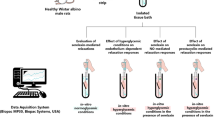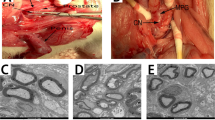Abstract
To investigate the pharmacodynamics of phentolamine in human corpus cavernosum (HCC) with special attention to the role of the K+ channels. Strips of HCC precontracted with nonadrenergic stimuli and kept in isometric organ bath immersed in a modified Krebs–Henseleit solution enriched with guanethidine and indomethacine were used in order to study the mechanism of the phentolamine-induced relaxation. Phentolamine caused relaxation (≈50%) in HCC strips precontracted with K+ 40 mM. This effect was not blocked by tetrodotoxin (1 μM) (54.6±4.6 vs 48.9±6.4%) or (atropine (10 μM) (52.7±6.5 vs 58.6±5.6%). However, this relaxation was significantly attenuated by L-NAME (100 μM) (59.7±5.8 vs 27.8±7.1%; P<0.05; n=8) and ODQ (100 μM) (62.7±5.1 vs 26.8±3.9%; P<0.05; n=8). Charybdotoxin and apamin (KCa-channel blockers) did not affect the phentolamine relaxations (54.6±4.6 vs 59.3±5.2%). Glibenclamide (100 μM), an inhibitor of KATP-channel, caused a significant inhibition (56.7±6.3 vs 11.3±2.3%; P<0.05; n=8) of the phentolamine-induced relaxation. In addition, the association of glibenclamide and L-NAME almost abolished the phentolamine-mediated relaxation (54.6±5.6 vs 5.7±1.4%; P<0.05; n=8). The results suggest that phentolamine relaxes HCC by a nonadrenergic–noncholinergic mechanism dependent on nitric oxide synthase activity and activation of KATP-channel.
This is a preview of subscription content, access via your institution
Access options
Subscribe to this journal
Receive 8 print issues and online access
$259.00 per year
only $32.38 per issue
Buy this article
- Purchase on Springer Link
- Instant access to full article PDF
Prices may be subject to local taxes which are calculated during checkout






Similar content being viewed by others
References
McKinlay JB . The worldwide prevalence and epidemiology of erectile dysfunction. Int J Impot Res 2000; 12 (Suppl 4): S6–S11.
Moreira Jr ED et al. Prevalence and correlates of erectile dysfunction: results of the Brazilian study of sexual behavior. Urology 2001; 58: 583–588.
Moreira Jr ED et al. Incidence of erectie dysfunction in men 40–69 years old: results from a populational-based cohort study in Brazil. Urology 2003; 61: 431–436.
Dollery C . Phentolamine mesylate. In: Dollery C (2nd ed). Therapeutic Drugs. Churchill Livingstone: New York, 1999 pp 97–99.
Krane RJ, Goldstein I, Saenz de Tejada I . Medical progress: impotence. N Engl J Med 1989; 321: 1648–1659.
Traish A et al. Phentolamine mesylate relaxes penile corpus cavernosum tissue by adrenergic and non-adrenergic mechanisms. Int J Impot Res 1998; 10: 215–223.
Vemulapalli S, Kurowski S . Phentolamine mesylate relaxes rabbit corpus cavernosum by a nonadrenergic noncholinergic mechanism. Fundam Clin Pharmacol 2001; 15: 1–7.
Holmquist F, Anderson KE, Fovaeus M, Hedlung H . K+ channel openers for relaxation of isolated penile erectile tissue from rabbit. J Urol 1990; 144: 146–151.
Hedlung P, Holmquist F, Hedlung H, Anderson KE . Effects of nicorandil on human isolated corpus cavernosum and cavernosu artery. J Urol 1994; 151: 1107–1113.
Malysz J et al. Potassium outward currents in freshly dissociated rabbit corpus cavernosum myocytes. J Urol 2001; 166: 1167–1177.
Lee SW, Wang HZM, Christ GJ . Characterization of ATP-sensitive potassium channels in human corporal smooth muscle cells. Int J impot Res 1999; 11: 179–188.
Gwinup G . Oral phentolamine in nonspecific erectile insufficiency. Ann Intern Med 1988; 109: 162–163.
Goldstein I, Carson C, Rosen R, Islam A . Vasomax for the treatment of male erectile dysfunction. World J Urol 2001; 19: 51–56.
Brock G . Oral phentolamine (Vasomax(r)). Drugs Today (Barc) 2000; 36: 121–124.
Hatzichristou DG et al. Effects of oral phentolamine, taken before sleep, on nocturnal erectile activity: a double-blind, placebo-controlled, crossover study. Int J Impot Res 2001; 13: 303–308.
Parma-Nathan H, Aroma Study Group et al. Long-term safety and efficacy of oral phentolamine mesylate (Aroma) in men with mild to moderate erectile dysfunction. Int J Impot Res 2002; 14: 266–270.
Yang DZ, Ma XN, Yu ZJ, Jiao Y . Assessment of curative effect on erectile dysfunction of two drugs. Zhonghua Nan Ke Xue 2003; 9: 260–262.
Palea S, Barras M . Comparison of the relaxant effects of alfuzosin, phentolamine and sildenafil on rabbit isolated corpus cavernosum. BJU Int 2003; 91: 873–877.
Rembold CM . Electromechanical and pharmacomechanical coupling. In: Baraby M (ed). Biochemistry of Smooth Muscle Contraction. Academic Press: San Diego, 1996 pp 227–239.
Wang HZ, Lee SW, Christ GJ . Comparative studies of the maxi-K (Kca) channel in freshly isolated myocytes in human and rat corpora. Int J impot Res 2000; 12: 9–18.
Giraldi A, Wagner G . Effects of pinacidil upon penile erectile tissue, in vitro and in vivo. Pharmacol Toxicol 1990; 67: 235–238.
Hellstrom WJG, Wang R, Kadowitz PJ, Domer FR . Potassium channel agonists cause penile erection in cats. Int J Impot Res 1992; 4: 35.
Christ GJ et al. Gap junctions and ion channels: relevance to erectile dysfunction. Int J. Impot Res 2000; 12: S15–S20.
Anderson KE . Pharmacology of penile erection. Pharmacol Ver 2001; 53: 417–450.
Hsieh GC, Kolasa T, Sullivan JP, Brioni JD . Dual mechanism of action of nicorandil on rabbit corpus cavernosal smooth muscle tone. Int J Impot Res 2001; 13: 240–246.
Lin RJ et al. KMUP-1 relaxes rabbit corpus cavernosum smooth muscle in vitro and in vivo: involvement of cyclic GMP and K(+) channels. Br J Pharmacol 2002; 135: 1159–1166.
Venkateswarlu K et al. Potassium channels and human corporeal smooth muscle cell tone: diabetes and relaxation of human corpus cavernosum smooth muscle by adenosine triphosphate sensitive potassium channel openers. J Urol 2002; 168: 355–361.
Author information
Authors and Affiliations
Corresponding author
Rights and permissions
About this article
Cite this article
Silva, L., Nascimento, N., Fonteles, M. et al. Phentolamine relaxes human corpus cavernosum by a nonadrenergic mechanism activating ATP-sensitive K+ channel. Int J Impot Res 17, 27–32 (2005). https://doi.org/10.1038/sj.ijir.3901269
Received:
Revised:
Accepted:
Published:
Issue Date:
DOI: https://doi.org/10.1038/sj.ijir.3901269
Keywords
This article is cited by
-
Relaxant effect of a metal-based drug in human corpora cavernosa and its mechanism of action
International Journal of Impotence Research (2016)
-
The effects of the combined use of a PDE5 inhibitor and medications for hypertension, lower urinary tract symptoms and dyslipidemia on corporal tissue tone
International Journal of Impotence Research (2012)
-
Phentolamine inhibits the pacemaker activity of mouse interstitial cells of Cajal by activating ATP-sensitive K+ channels
Archives of Pharmacal Research (2010)
-
Yohimbine relaxes the human corpus cavernosum through a non-adrenergic mechanism involving the activation of K+ATP-dependent channels
International Journal of Impotence Research (2009)



